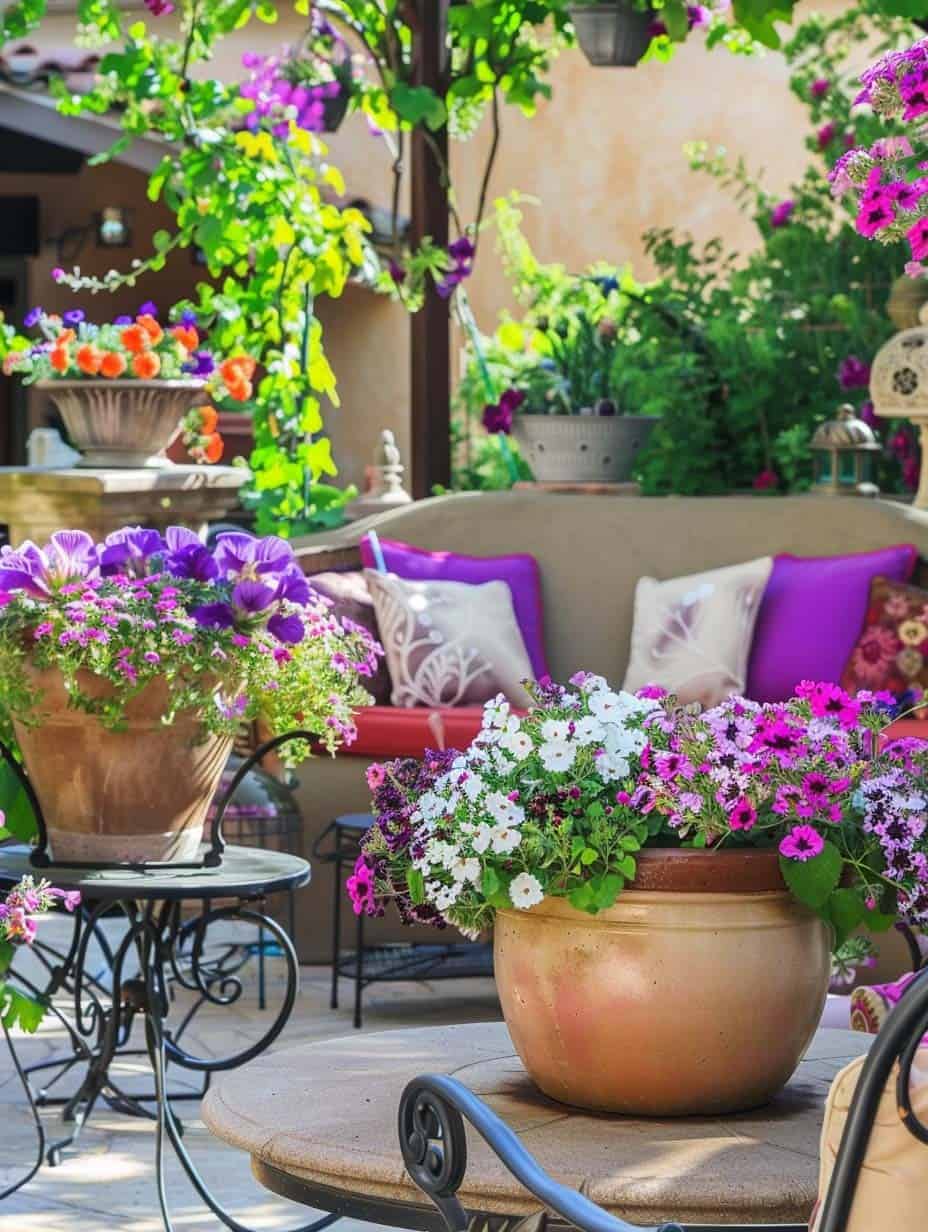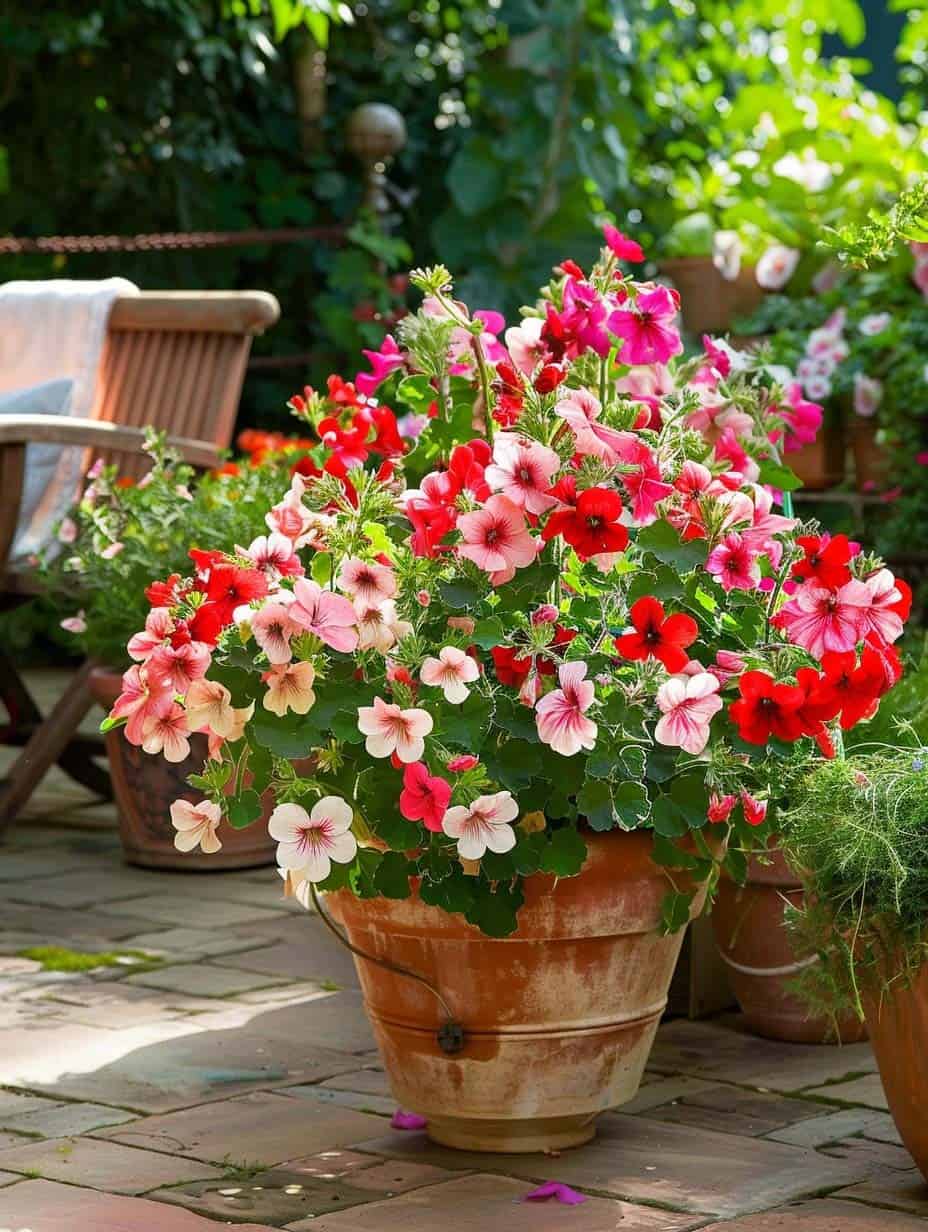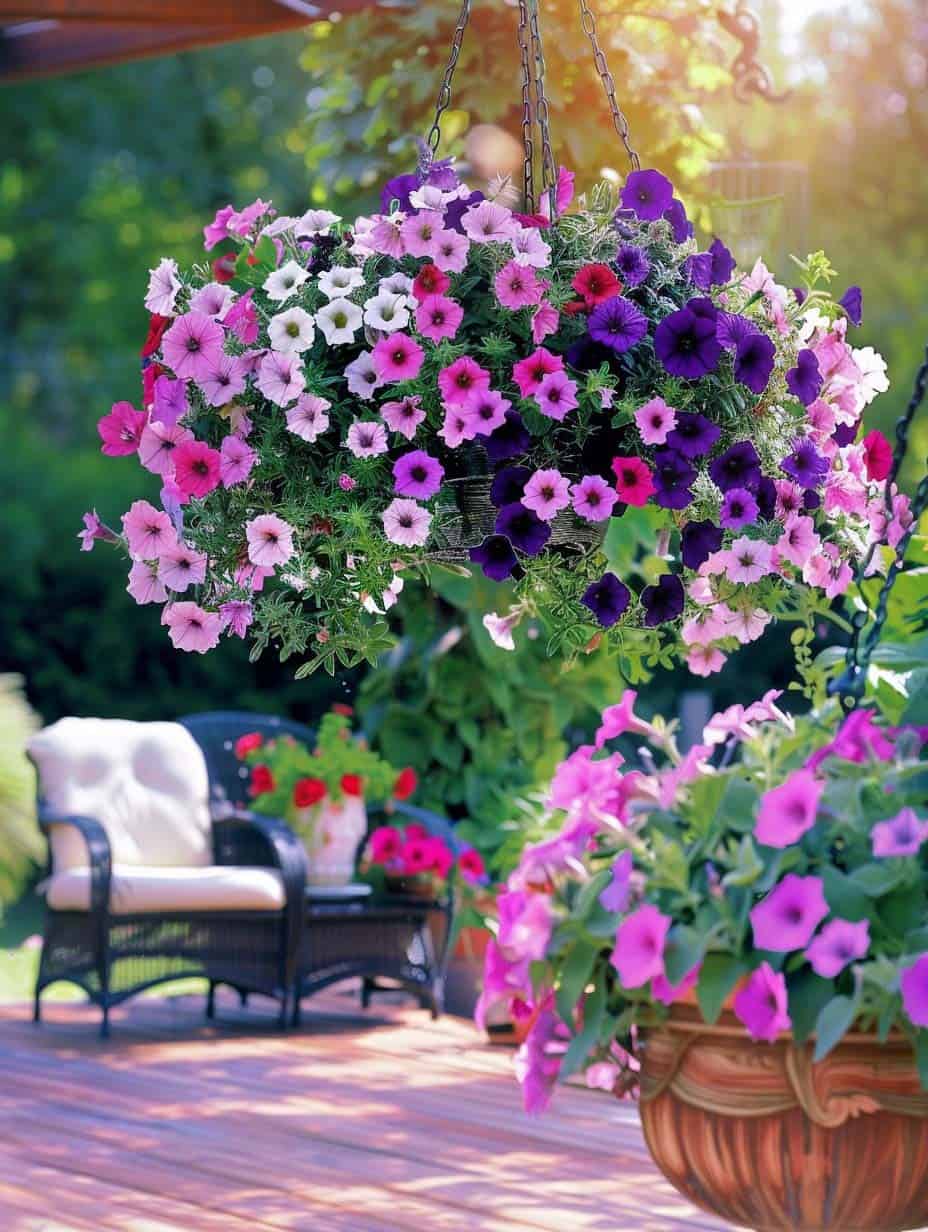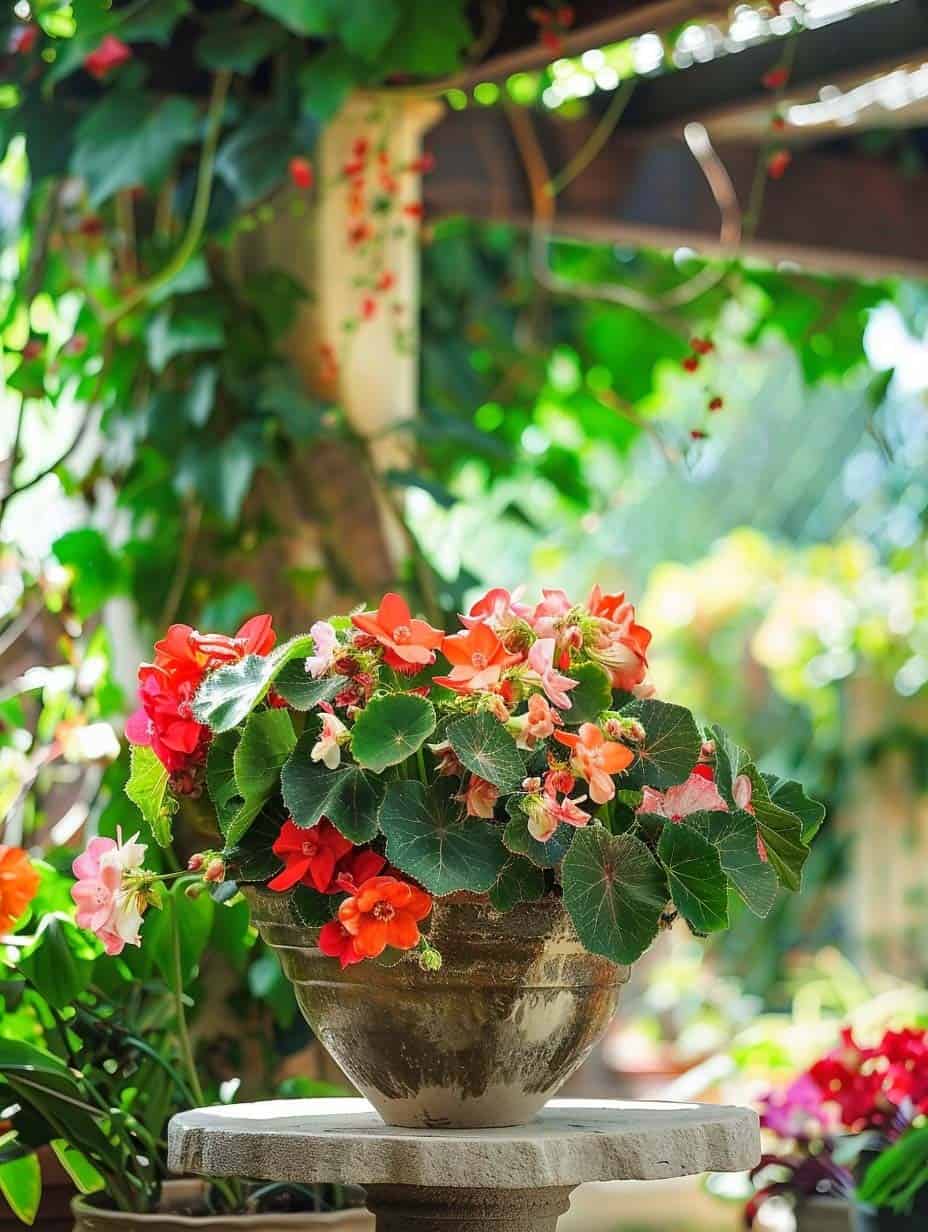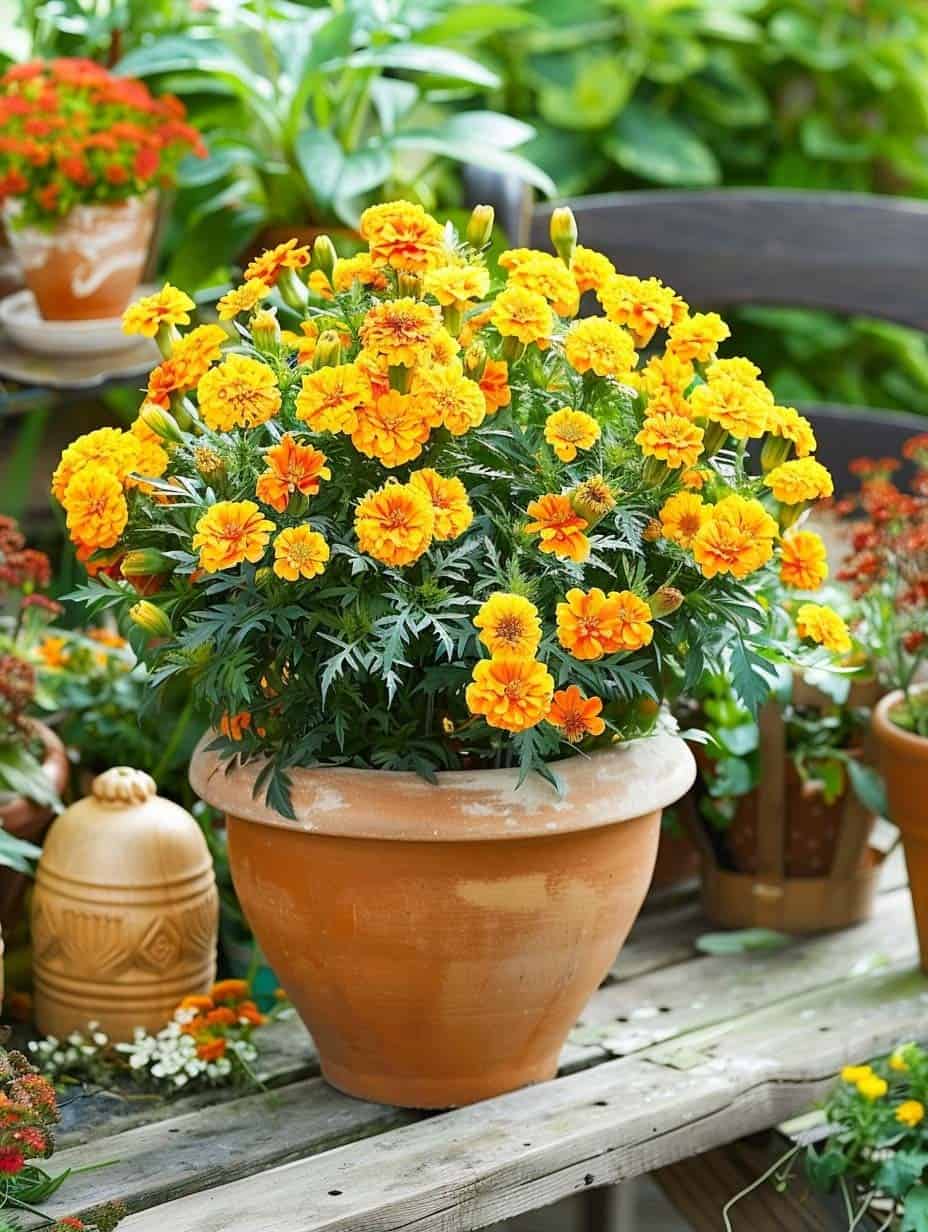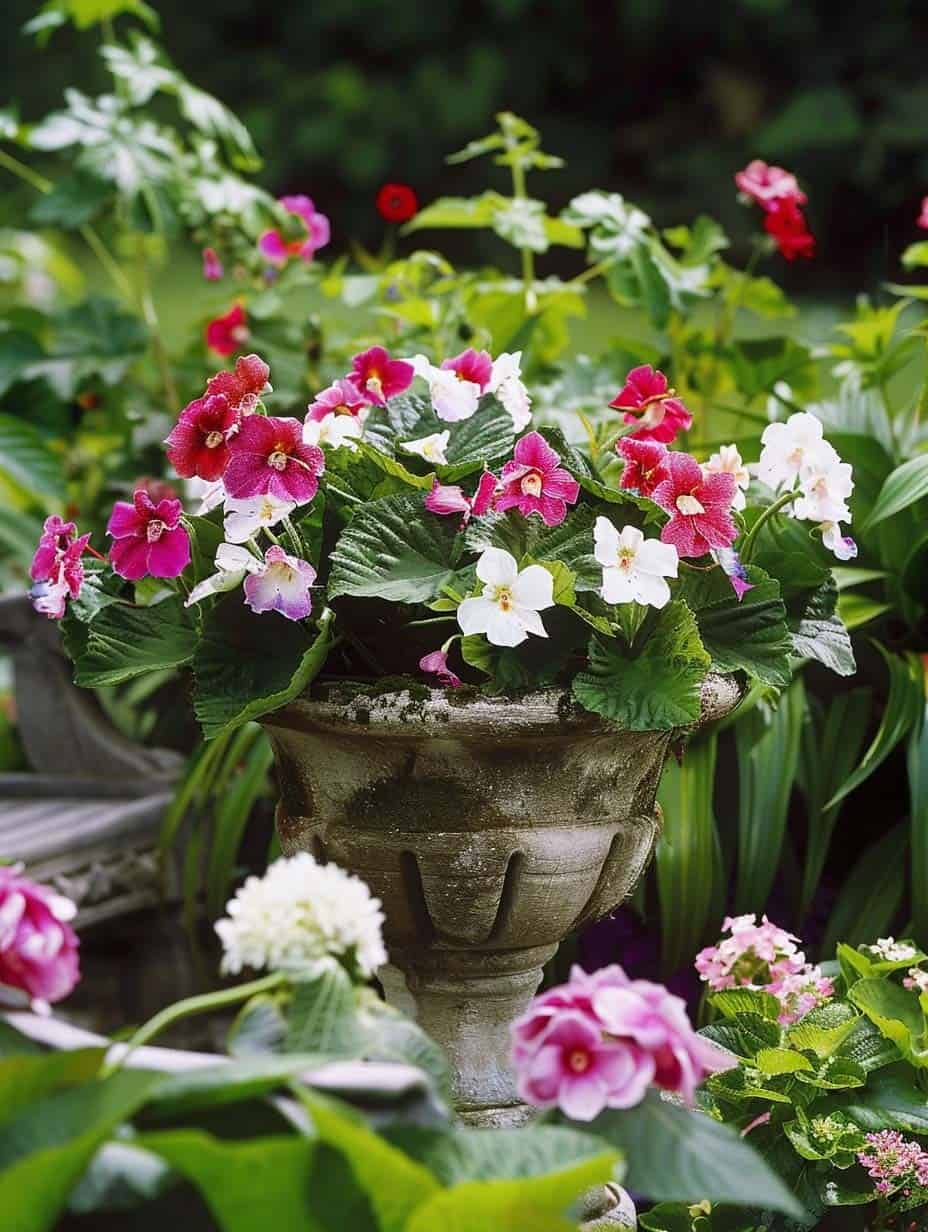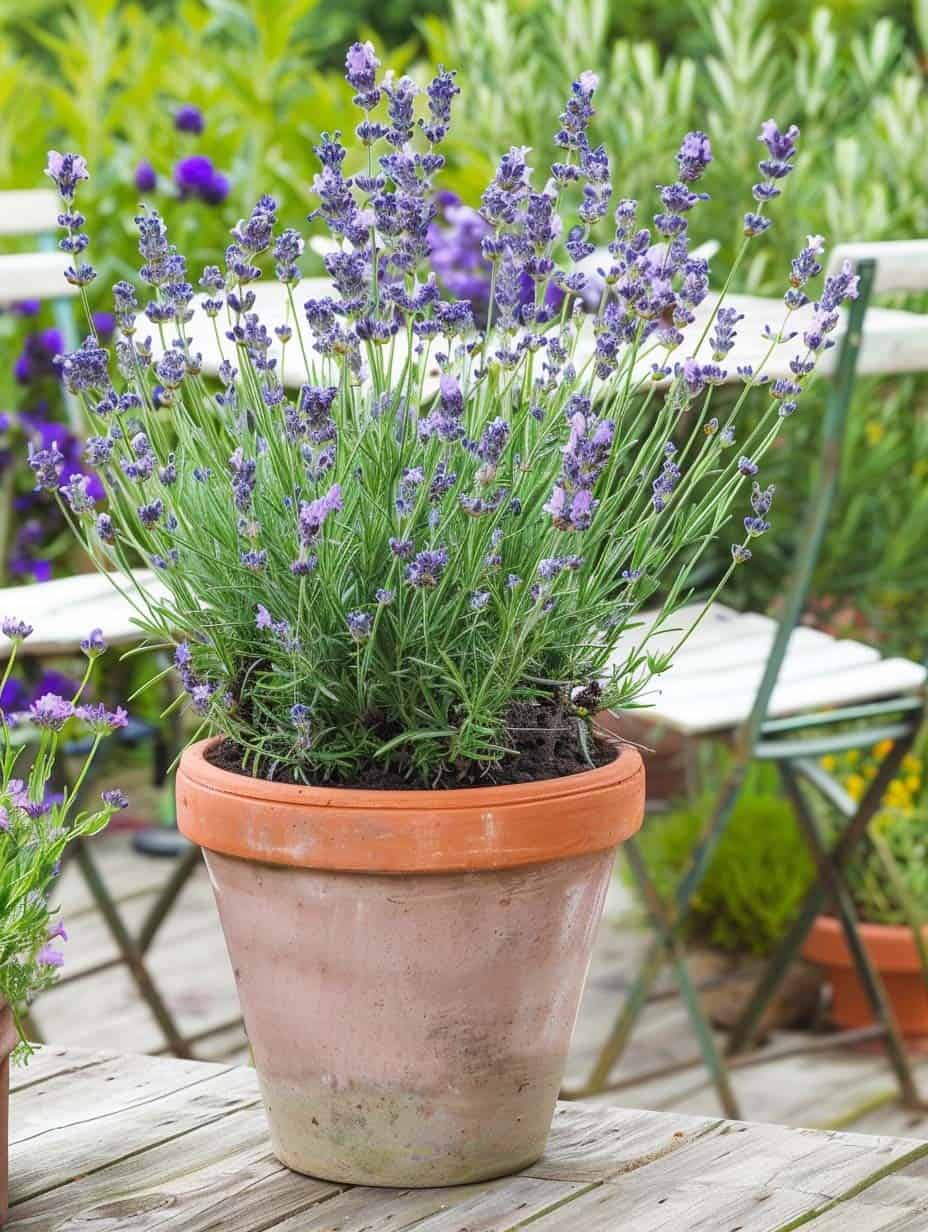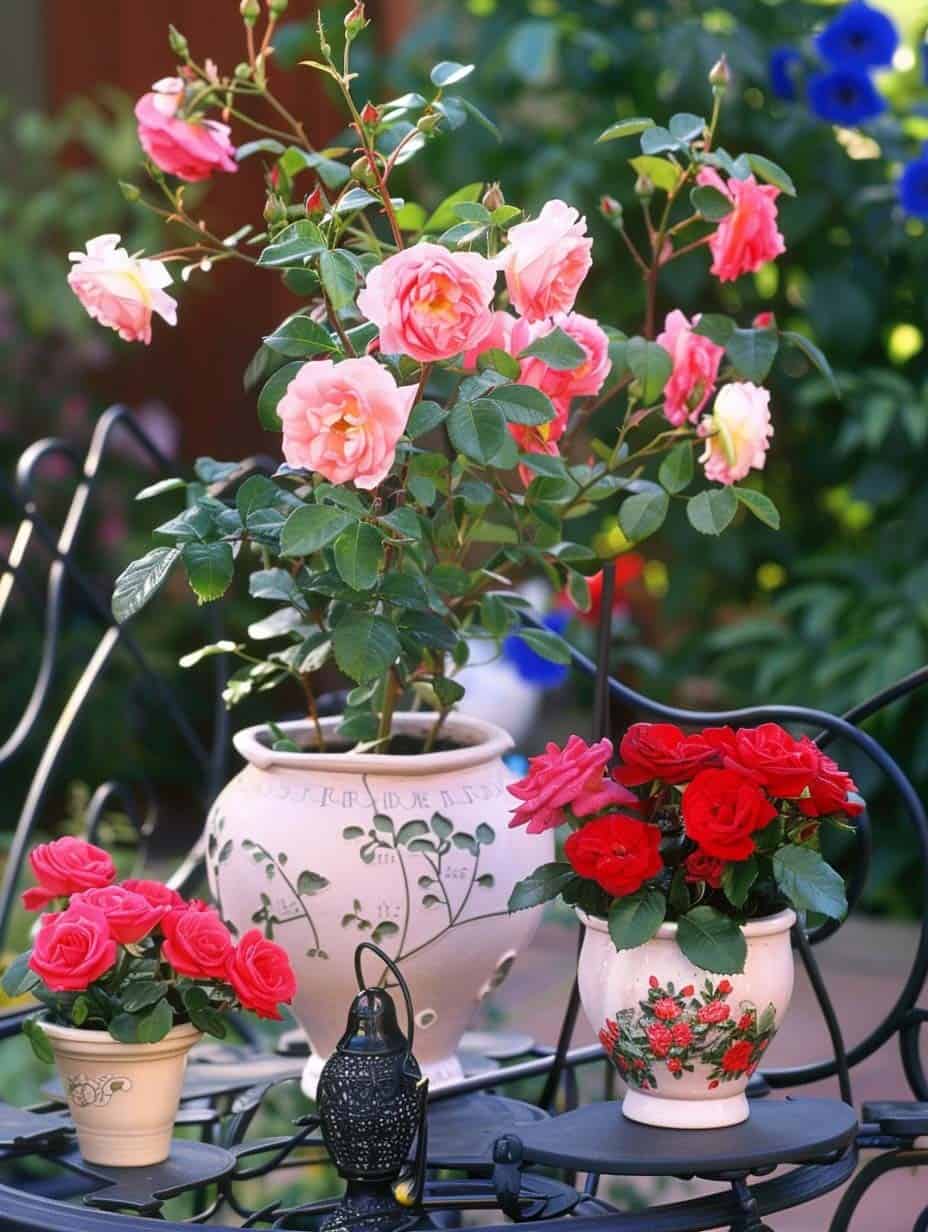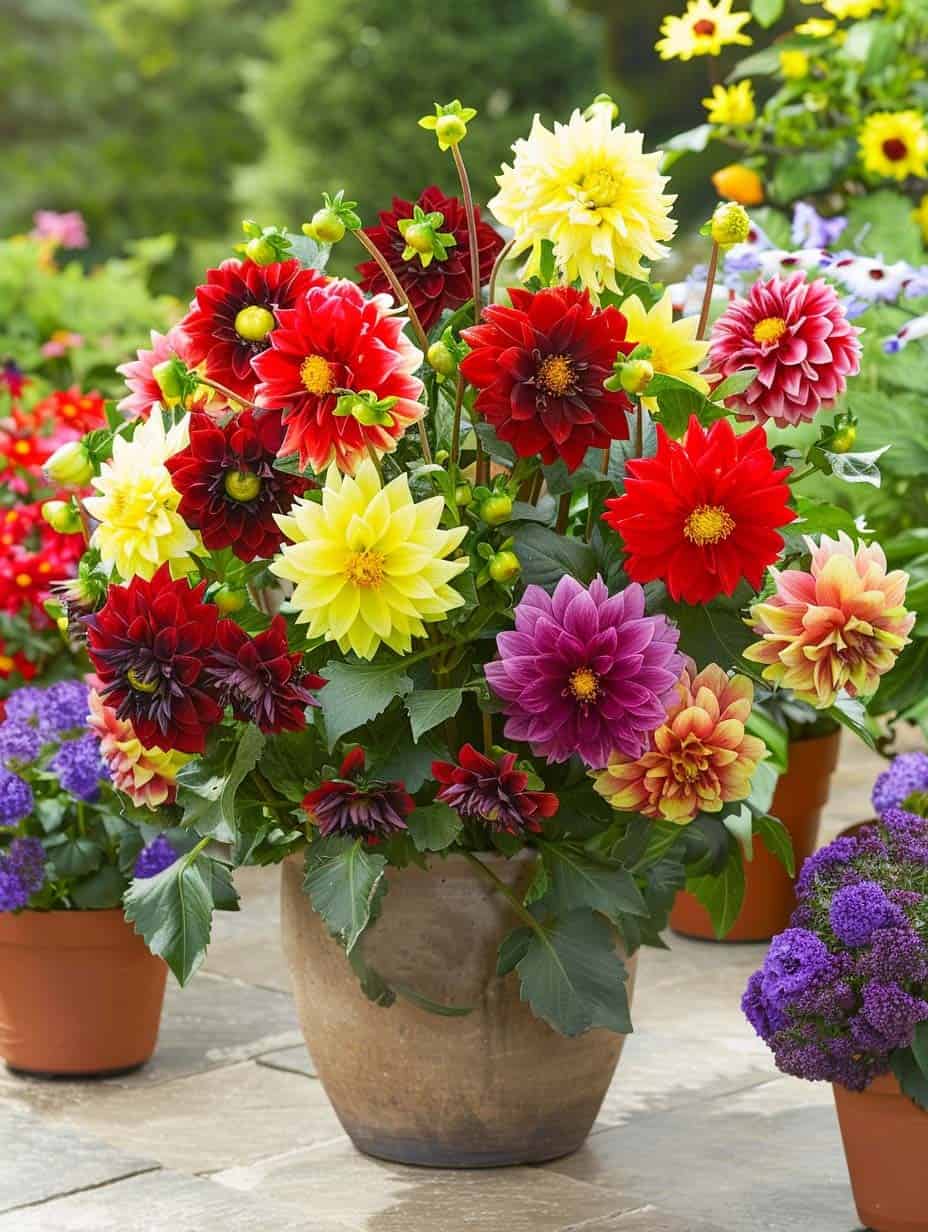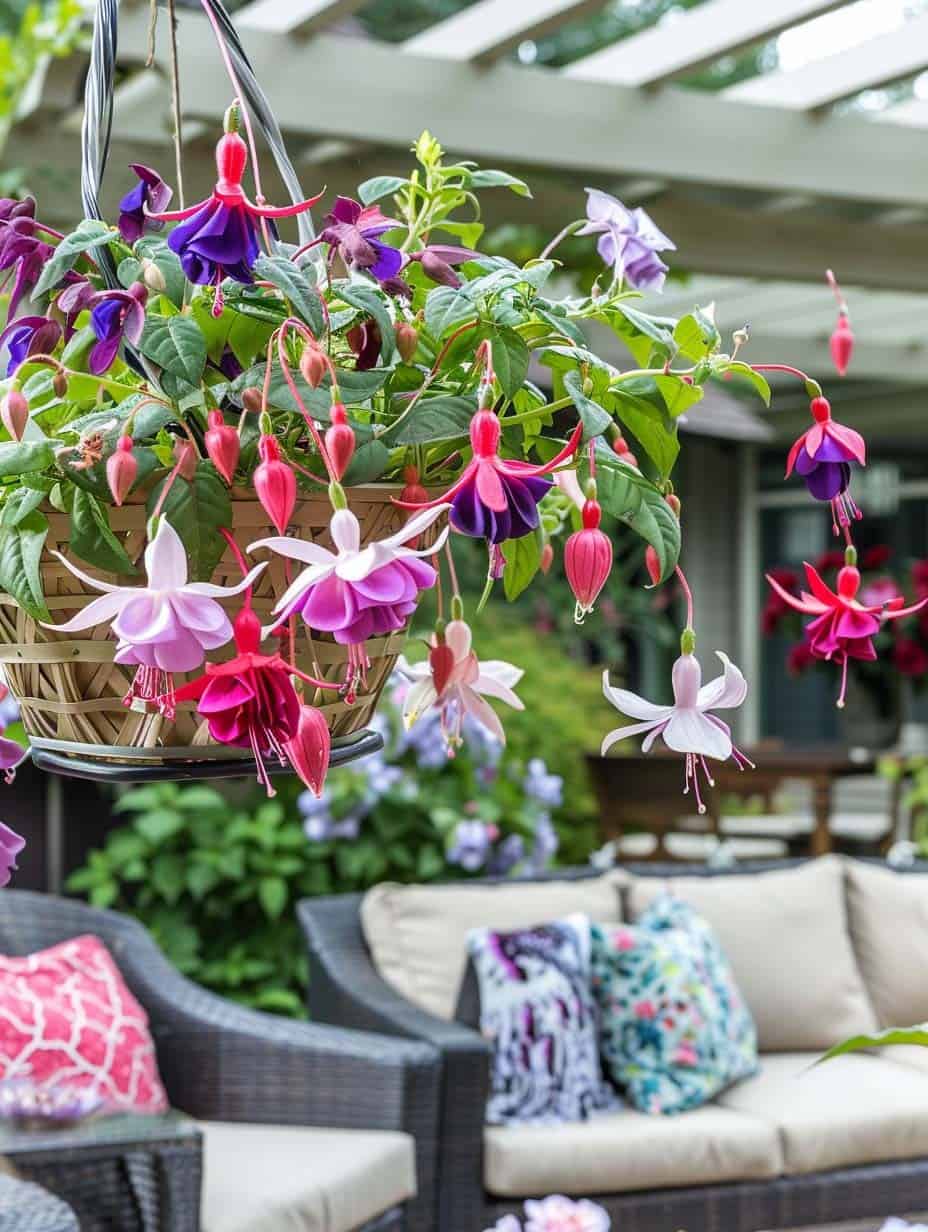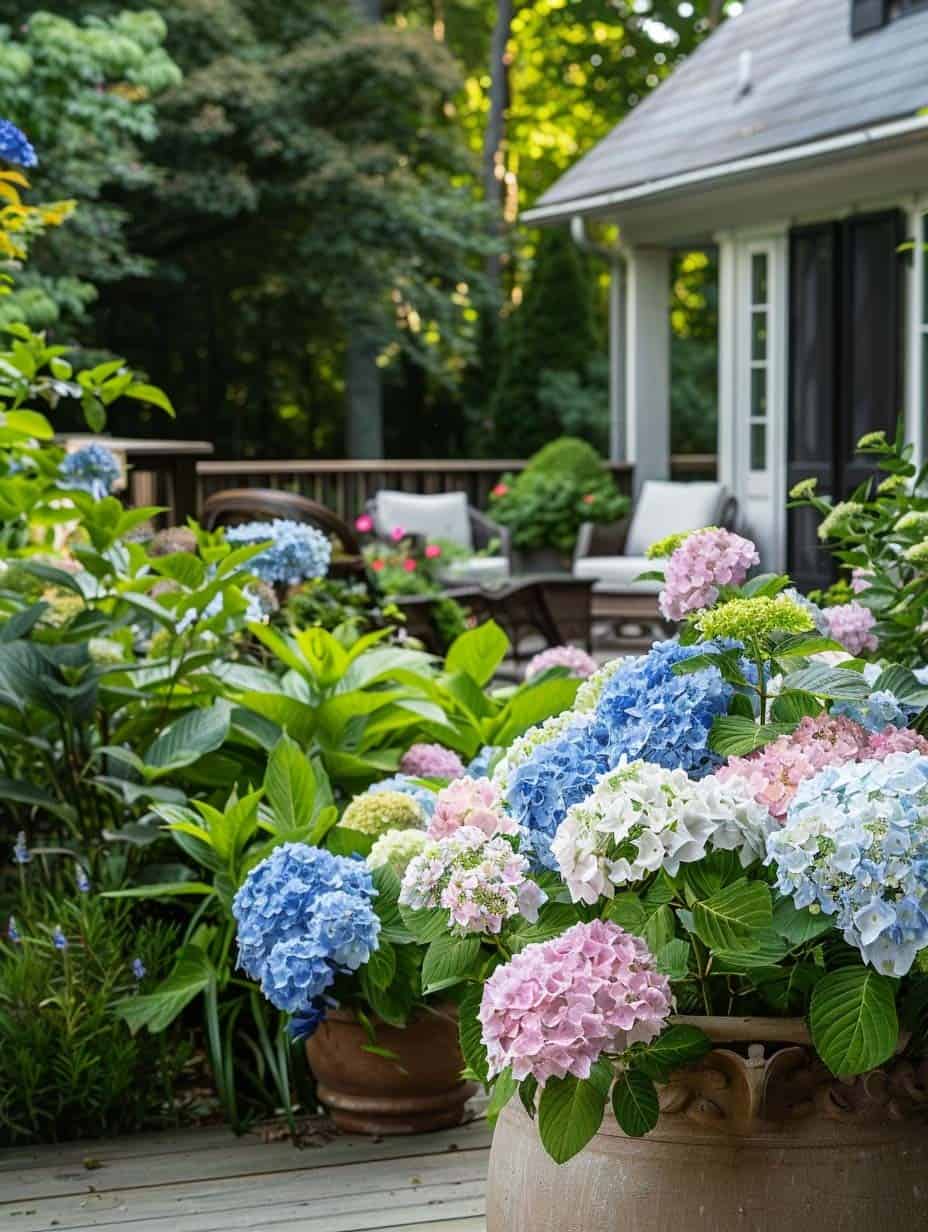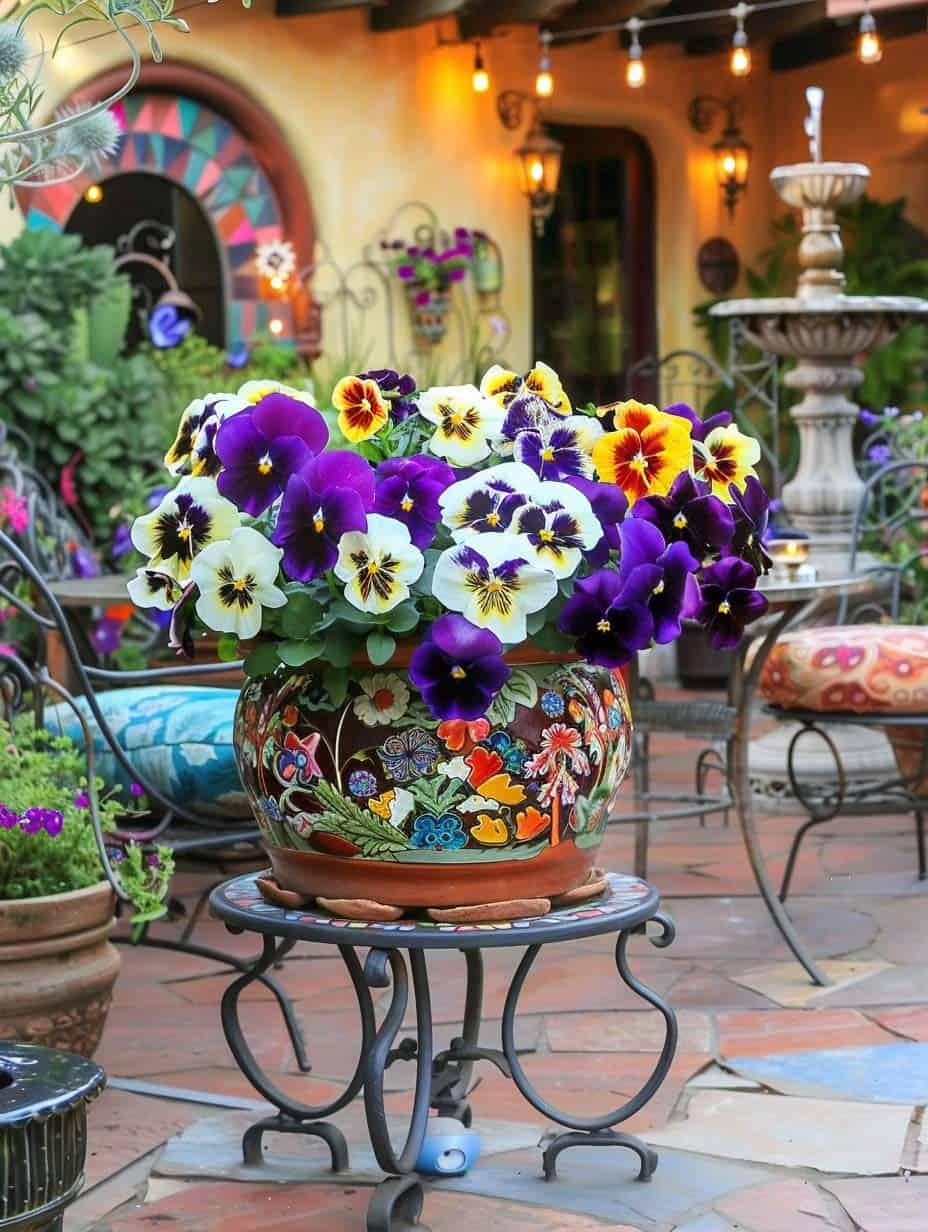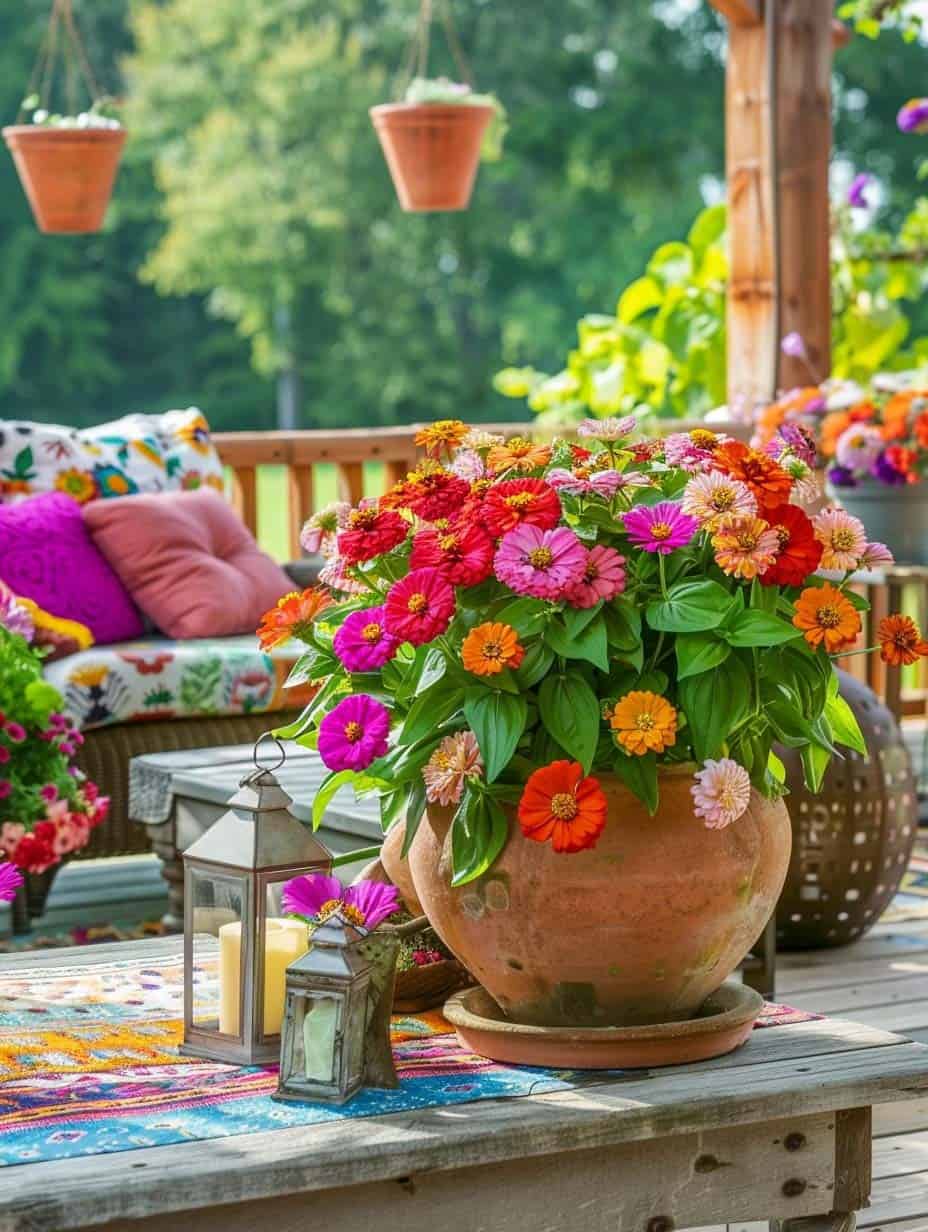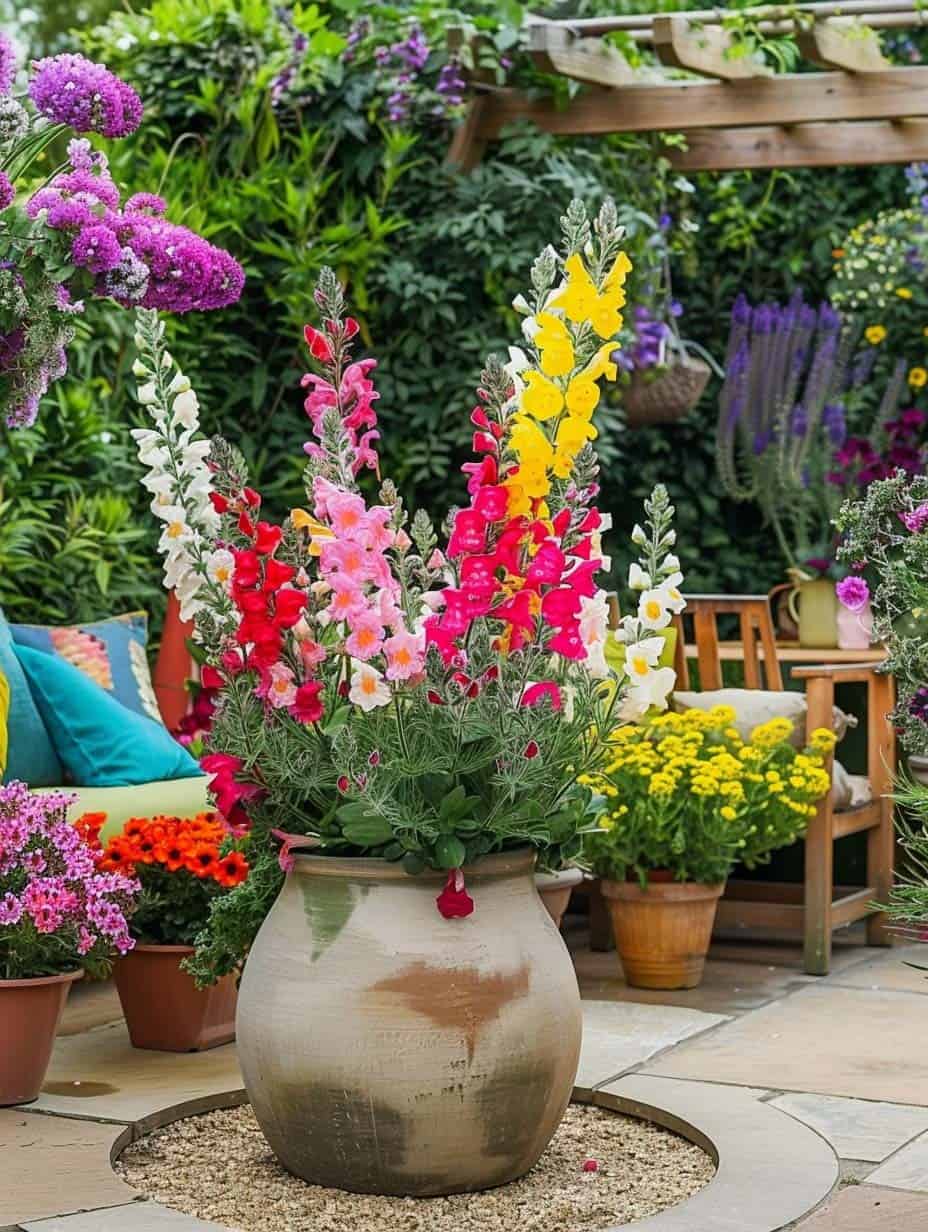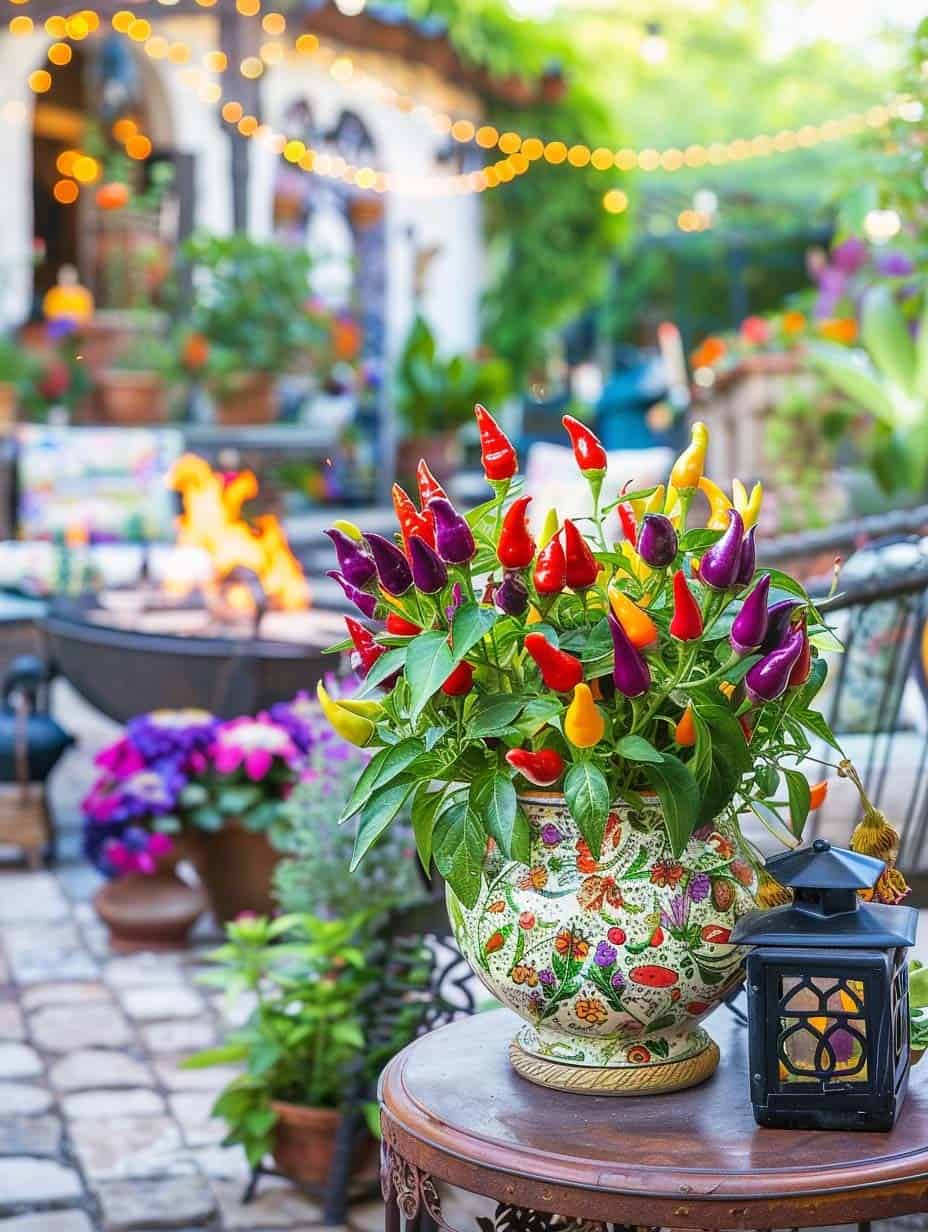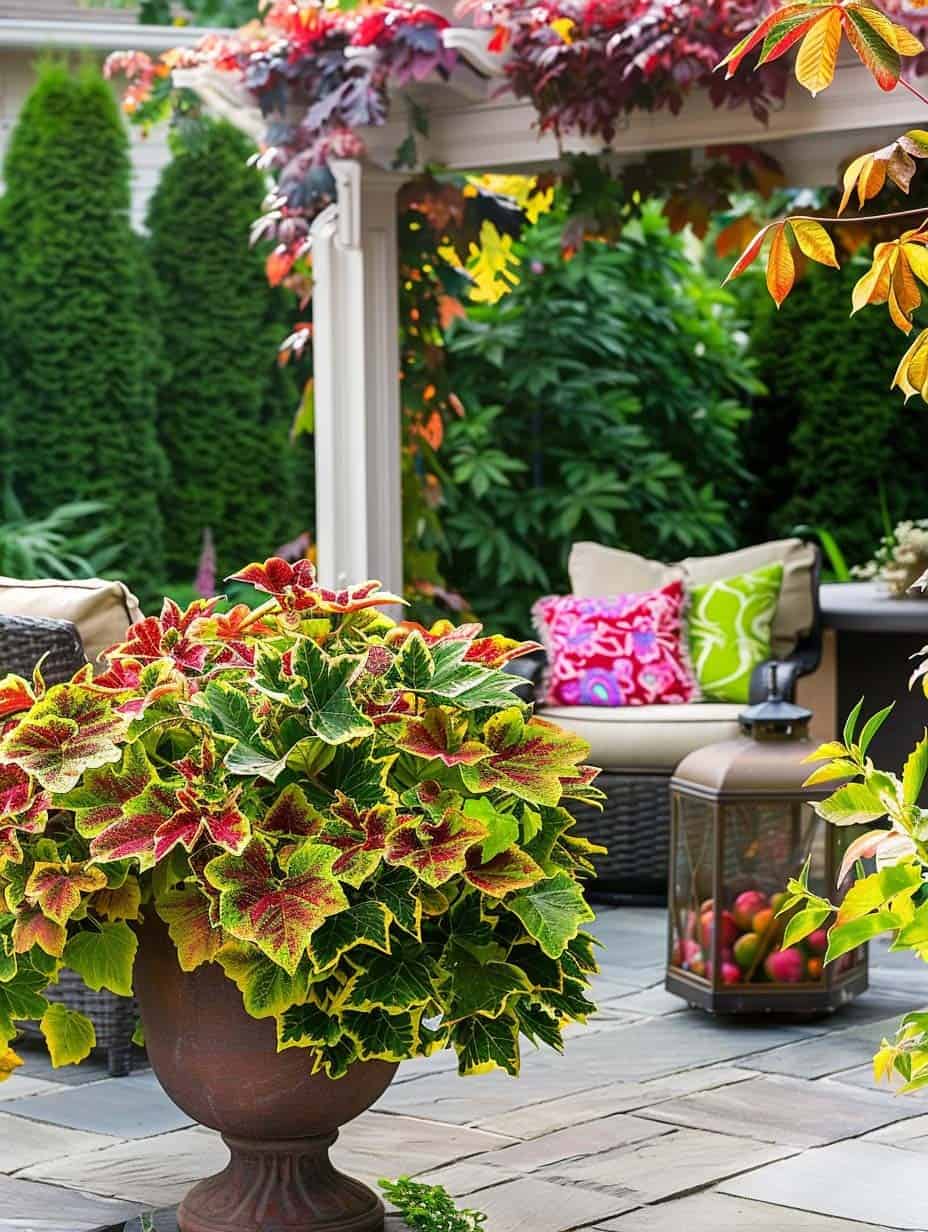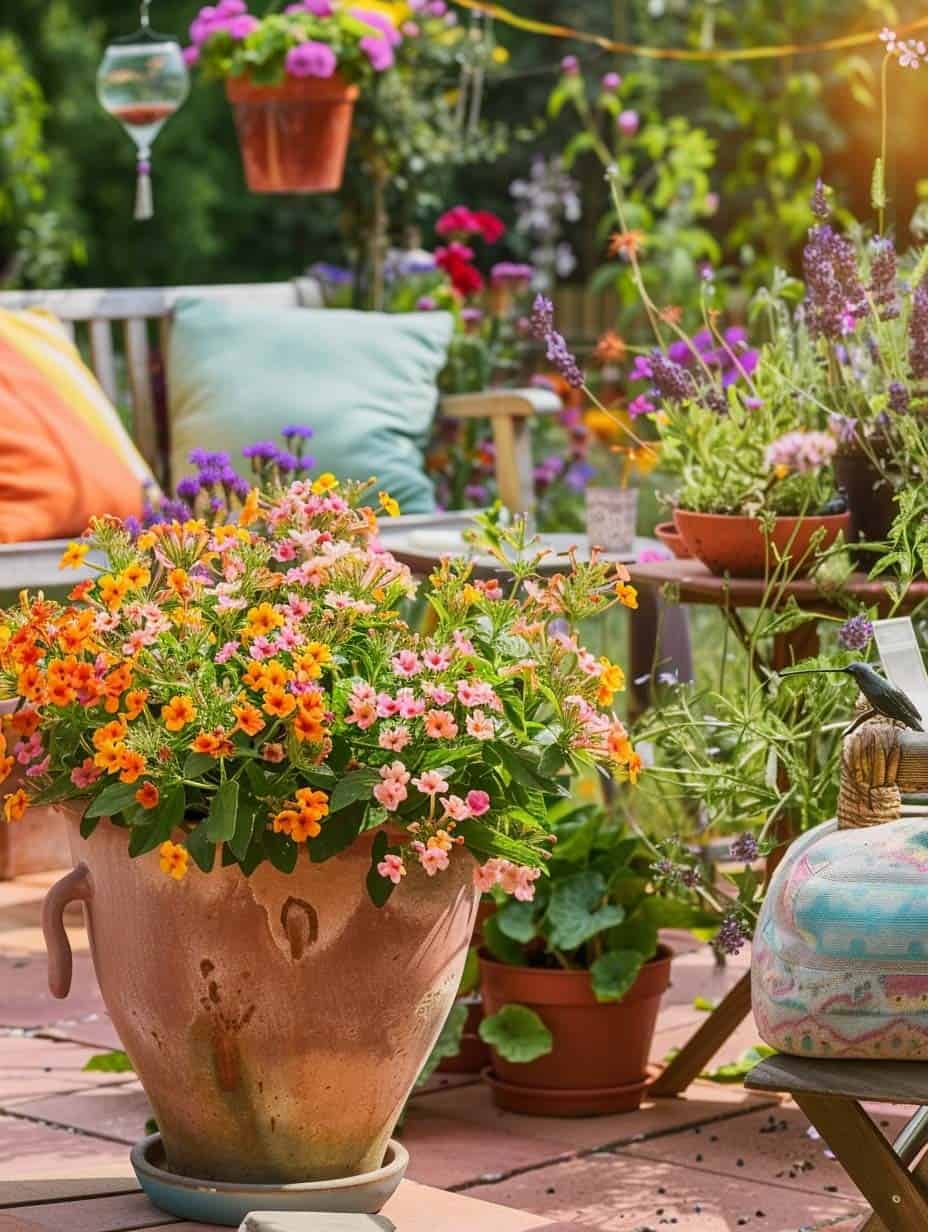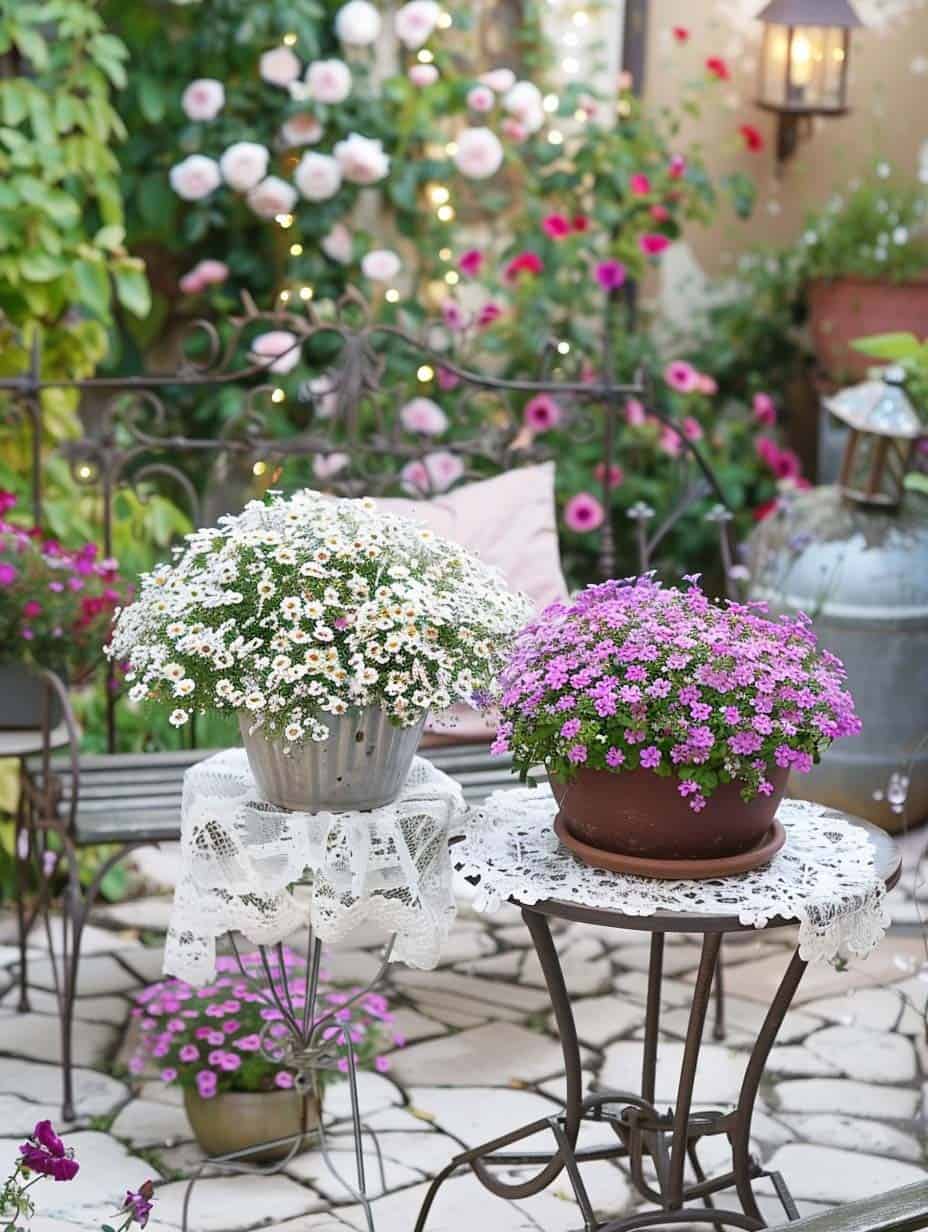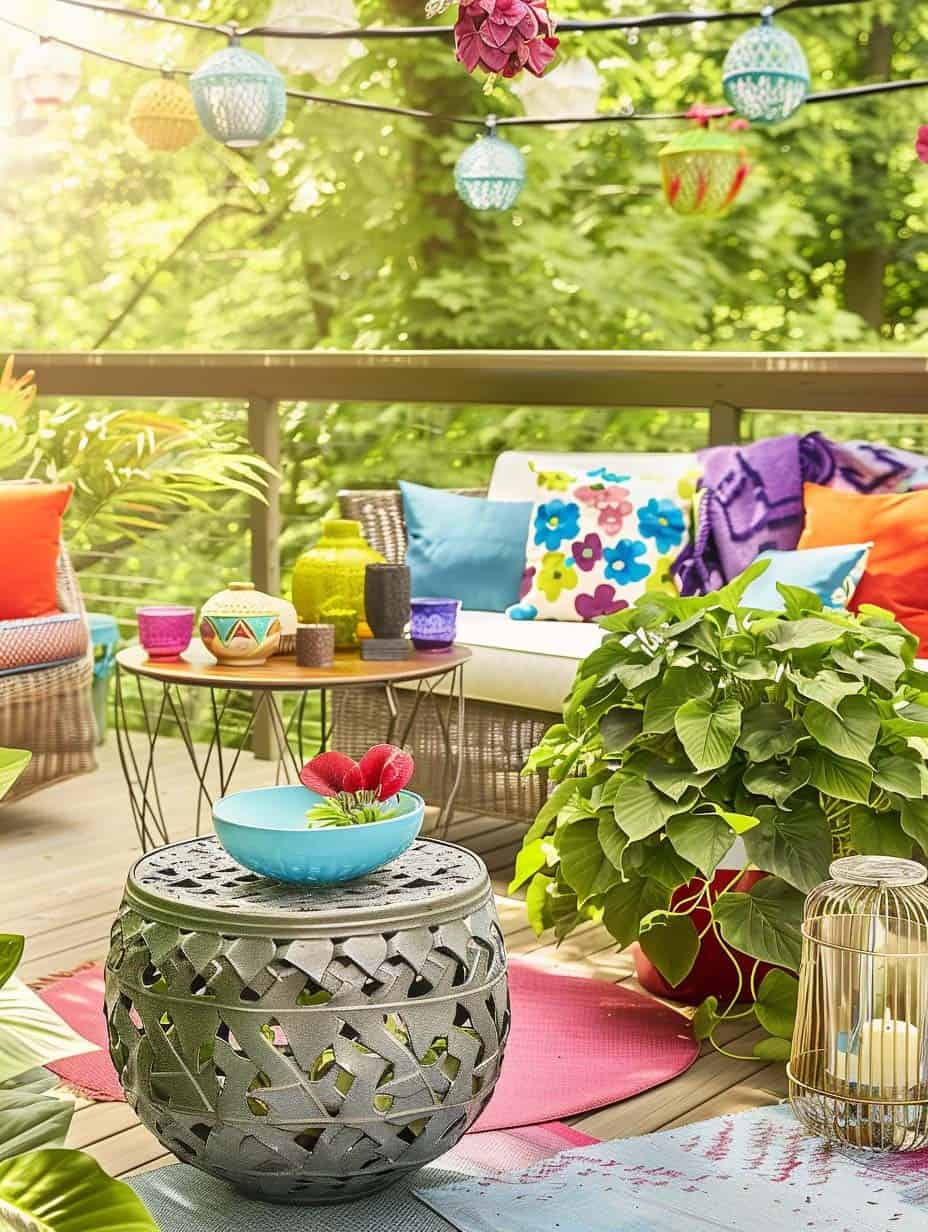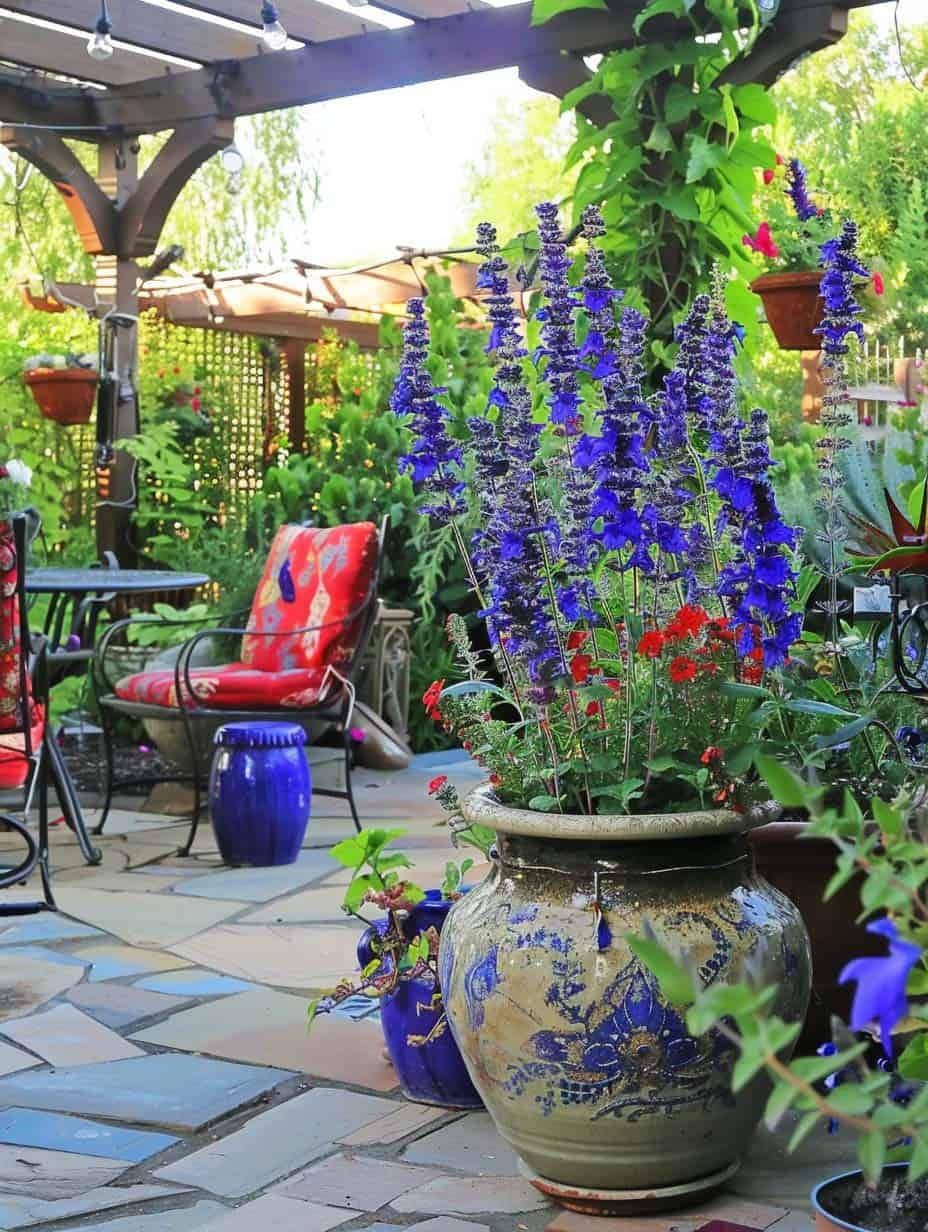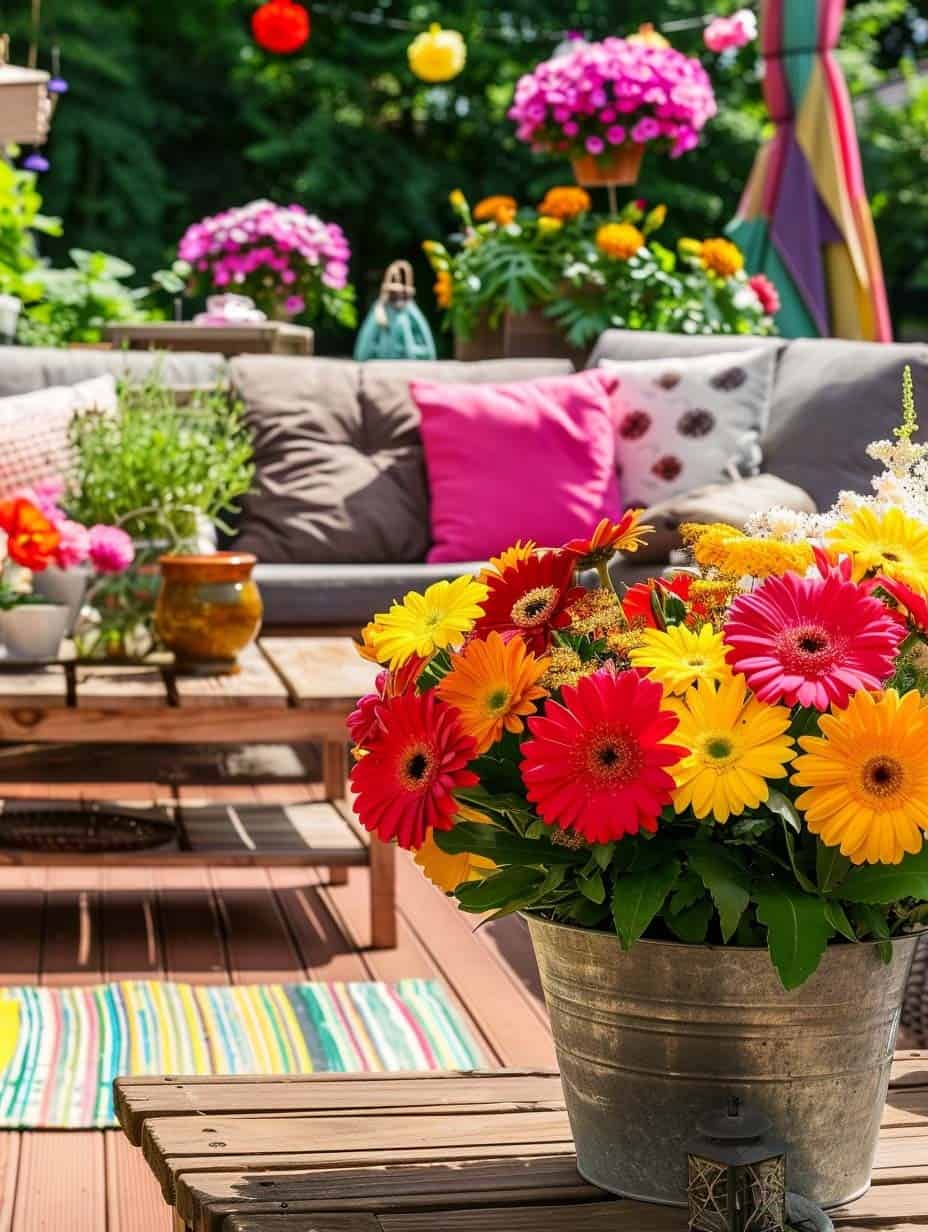Elevate your outdoor oasis by incorporating 22 exquisite potted flowers into your patio design. This diverse collection of blooms, foliage, and fragrances is sure to transform your space into a serene haven that’s both visually striking and inviting. From the vibrant geraniums that make a bold statement to the soothing lavender that fills the air with its calming aroma, each of these plants offers a unique charm that can be leveraged to create a truly unforgettable patio experience.
Get ready to be inspired by the stunning floral options at your disposal and bring your patio to life.
Geraniums
Geraniums are a popular choice for patio containers due to their vibrant colors and extended blooming period. These hardy flowers exhibit remarkable adaptability, thriving in various climates and requiring minimal maintenance. This makes them an excellent option for both novice and experienced gardeners alike. The diverse color palette of geraniums – including red, pink, white, and purple hues – allows you to curate a stunning and inviting patio space that’s sure to draw attention.
As you might expect, geraniums have specific preferences when it comes to their growing conditions. They tend to perform best in well-drained soil and full sun, though they can tolerate partial shade if necessary. Regular watering is crucial, particularly during hot spells, but be mindful of overwatering, as this can lead to root rot.
In addition to their attractive blooms, geraniums offer several practical benefits.
For instance, the essential oils in these flowers possess natural insect-repelling properties that can help deter pests like mosquitoes, making them a valuable addition to your outdoor space.
Furthermore, certain varieties of geraniums – such as scented geraniums – can release pleasant fragrances into the air, further enhancing your patio experience.
With their low-maintenance requirements and numerous benefits, it’s no wonder that geraniums are a favorite among gardeners seeking to add some color and charm to their patios.
USDA Zones: 9-12 (can be grown as annuals in cooler zones)
Petunias
Petunias are a staple of patio gardening due to their adaptability and profuse blooming. With a kaleidoscope of colors and patterns, these flowers offer endless possibilities for creative arrangements. Their versatility extends to their growth habits, too, as they can thrive in hanging baskets, containers, or garden beds, making them an excellent choice for any patio design.
To keep petunias healthy, they require full sun and well-drained soil.
Regular watering is essential, and the occasional feeding with a balanced fertilizer can encourage continuous blooms.
One of the unique advantages of petunias is their self-cleaning nature, where spent flowers naturally drop off, eliminating the need for deadheading.
Interestingly, some petunia varieties, particularly grandiflora types, emit a sweet fragrance in the evening, adding an extra layer of sensory delight to your patio experience.
This makes them an ideal choice for patios where you’ll be relaxing in the evenings.
Best USDA Zones: 9-11 (can be grown as annuals in cooler zones)
Begonias
Begonias are a fantastic option for shaded patios due to their ability to flourish in low-light conditions. These flowers are renowned for their striking foliage and vibrant blooms, which can add a pop of color to any shady spot. With multiple varieties to choose from, including wax begonias, tuberous begonias, and rex begonias, each offering unique foliage and flowers, you’re sure to find the perfect one for your space.
Begonias have specific growing requirements, preferring well-drained soil and regular watering, but they can be susceptible to overwatering. They thrive in partial to full shade and can tolerate indirect sunlight, making them a great choice for busy gardeners or those new to gardening. Additionally, these plants are relatively low maintenance. What’s more, begonias have been used in traditional medicinal practices for their anti-inflammatory properties.
Not only do they offer aesthetic appeal, but they also provide functional benefits by filtering toxins from the air, making them a beneficial addition to your patio. When it comes to growing begonias, consider planting them in USDA zones 10-11, where they can be grown as perennials. In cooler zones, they can be grown as annuals.
Marigolds
Marigolds are a fantastic option for patio containers due to their vibrant colors and low-maintenance requirements. These flowers boast impressive hardiness and can thrive in a range of conditions, making them perfect for adding a pop of color to your outdoor space. With a continuous blooming period from spring until the first frost, marigolds come in a variety of shades including yellow, orange, and red.
While they prefer full sun and well-drained soil, marigolds can tolerate poor soil conditions, making them a great choice for patios with less-than-ideal growing conditions. Watering regularly is sufficient, but deadheading spent flowers can encourage additional blooms and keep your patio looking lively throughout the growing season.
One of the most interesting aspects of marigolds is their pest-repellent properties.
These flowers emit a scent that naturally deters many common garden pests, including nematodes, aphids, and even mosquitoes. This makes them an excellent choice for patios, helping to protect other plants and reduce the presence of pesky insects.
When it comes to growing marigolds, USDA Zones 2-11 are suitable, with these flowers being grown as annuals in colder regions.
Impatiens
Impatiens are a versatile and vibrant addition to any shaded patio or garden. Their ability to thrive in low-light conditions makes them an ideal choice for areas with limited sunlight. These flowers come in a stunning range of colors, including pink, red, white, and purple, making them perfect for adding a pop of color to your outdoor space.
They are well-suited for container gardening, hanging baskets, and garden beds in shaded areas, offering a unique and attractive way to add visual interest to your yard. Impatiens require moist, well-drained soil and regular watering, especially during hot and dry periods. They prefer partial to full shade, making them perfect for patios with limited sunlight.
One of the best things about impatiens is their low maintenance requirements – they don’t need frequent fertilization to flourish, making them a great choice for busy gardeners. In addition to their beauty and ease of care, impatiens have also been used in traditional medicine to treat minor skin ailments and inflammation. This adds an extra layer of interest and value to these already impressive flowers.
One of the best things about impatiens is their rapid growth and prolific blooming, making them a favorite among gardeners looking to quickly add color and vibrancy to their outdoor spaces. Whether you’re looking for a quick fix or a long-term solution, impatiens are an excellent choice. Best USDA Zones: 10-11 (can be grown as annuals in cooler zones)
Lavender
Lavender is an excellent choice for patio containers, boasting both aromatic properties and a visually appealing appearance. Its fragrant, purple blooms and silvery-green foliage add a touch of sophistication to any outdoor space. This perennial herb is also remarkably resilient, thriving in a variety of climates and requiring minimal maintenance. Lavender can tolerate drought-like conditions and does well in full sun with well-drained soil, making it an ideal selection for gardeners.
Once established, this low-maintenance plant requires only occasional pruning to remove spent blooms and maintain its shape. One of the most appealing aspects of lavender is its versatility; not only can its fragrant flowers be harvested for sachets, oils, and culinary dishes, but they also promote relaxation and reduce stress when used in aromatherapy. Additionally, this attractive plant attracts pollinators like bees and butterflies, enriching the biodiversity of your garden.
Lavender’s suitability makes it an excellent choice for patio containers in USDA zones 5-9.
Roses
Miniature patio roses are a fantastic way to add sophistication and fragrance to your outdoor space. These compact beauties are specifically bred to thrive in containers, making them perfect for small areas like patios or balconies. They offer the same stunning variety of colors as larger rose bushes, including vibrant reds, soft pinks, bright yellows, and pure whites.
Roses generally prefer full sun and well-drained soil, and they require regular watering and fertilization during their growing season. Pruning is crucial to maintain their shape and encourage new growth. While they may have slightly higher maintenance requirements compared to some other patio plants, the breathtaking blooms and intoxicating fragrance make them well worth the extra effort.
Interestingly, roses have been closely tied to love and beauty for centuries, often serving as a symbol of romance and elegance in celebrations and special occasions. Additionally, rose petals can be used to create fragrant rose water or added to dishes for a touch of floral flavor, adding a practical element to their ornamental value. In terms of USDA zones, roses are suitable for planting in zones 5-9, although specific varieties may have slightly different requirements.
Dahlias
Dahlias are a stunning choice for patio containers, boasting vibrant flowers that come in a wide array of colors and shapes. From delicate pom-poms to show-stopping dinner-plate-sized blooms, these flowers offer endless possibilities for adding visual interest to your outdoor space. With a blooming period that spans from mid-summer to the first frost, dahlias provide continuous color and beauty throughout the growing season.
To thrive, dahlias require full sun and well-drained soil rich in nutrients. Regular watering is essential, and a balanced fertilizer will help support their robust growth and abundant flowering. While some varieties may need staking to prevent their tall stems from toppling over, the reward of witnessing these dramatic blooms sway in the breeze makes the extra effort worthwhile. Interestingly, dahlias have a rich cultural history.
Originating in Mexico, they were once cultivated by the Aztecs for their edible tubers and medicinal properties. Today, we primarily enjoy them for their ornamental beauty, with their diverse forms and colors making them a favorite among gardeners and floral designers alike. Best USDA Zones: 8-11, though they can be grown as annuals or lifted and stored in cooler zones.
Fuchsias
Fuchsias bring a touch of sophistication and playfulness to shaded patios. With their distinctive, drooping flowers reminiscent of ballerinas, these colorful blooms come in a range of hues including pink, purple, red, and white. When grown in hanging baskets, fuchsias add vertical interest to your patio garden, creating a visually striking display. To thrive, fuchsias require partial to full shade and well-draining soil.
Regular watering is essential, while a balanced fertilizer during the growing season provides an added boost. For continuous blooms, be sure to remove spent flowers regularly. Fuchsias are relatively low-maintenance, making them an excellent choice for adding unique charm to your patio. Interestingly, fuchsias have been cultivated since the late 17th century, named after German botanist Leonhart Fuchs.
Their one-of-a-kind flower shape and vibrant colors have made them a beloved favorite in gardens worldwide, and they continue to be popular for their beauty and versatility. Best USDA Zones: 9-11 (can be grown as annuals in cooler zones)
Hydrangeas
Hydrangeas are a fantastic choice for patio containers, boasting vibrant blooms that can elevate any outdoor space. With their diverse color palette, ranging from blue and pink to white and purple, these flowers offer endless opportunities for customization. The soil pH plays a significant role in determining the final hue, allowing you to tailor your display to your personal taste.
Partial shade and well-drained soil are ideal conditions for hydrangeas, while regular watering, especially during hot weather, is crucial for their survival. Occasional feeding with a balanced fertilizer can also have a positive impact on their growth. Despite requiring some maintenance, hydrangeas are relatively low-maintenance plants that can provide stunning blooms from late spring to early autumn. What’s more, they possess an intriguing trait – the ability to change color based on soil pH.
For instance, blue hydrangeas may shift to pink if the soil becomes less acidic, while pink hydrangeas might turn blue if the soil becomes more acidic. This fascinating characteristic invites experimentation and adds a new layer of excitement to growing hydrangeas. When it comes to choosing the right hydrangea variety, consider USDA Zones 3-9 for optimal results.
Pansies
Pansies bring a splash of color and whimsy to any patio container with their cheerful blooms, thriving in cooler temperatures. The unique ‘faces’ on these flowers feature dark central markings contrasting with vibrant colors like purple, yellow, blue, and red. As a favorite among gardeners, pansies are a delightful choice for adding charm to your outdoor space.
These flowers do best in full sun to partial shade and prefer well-drained soil.
They’re relatively low maintenance and can tolerate cooler weather, making them perfect for spring and fall plantings. Regular watering and deadheading spent blooms will help extend their blooming period and keep your patio looking vibrant.
But did you know that pansies are also edible? Their flowers can be used to garnish salads, desserts, and drinks, adding a decorative touch with a mild, slightly sweet flavor. You can even candy them for a unique treat.
This versatility makes pansies not only a beautiful addition to your patio garden but also a practical one.
Best USDA Zones: 6-10 (grown as annuals or biennials)
Zinnias
Zinnias bring a burst of vibrant color and long-lasting blooms to any patio container. With their diverse range of shapes and sizes, from petite single-petaled flowers to showy doubles, the possibilities for creating stunning displays are endless. These flowers have an uncanny ability to transform a patio into a lively and inviting space, perfect for outdoor gatherings or simple relaxation.
Zinnias require minimal maintenance and thrive in full sun and well-drained soil, making them accessible to both novice and experienced gardeners. To encourage continuous blooming throughout the growing season, regular watering and deadheading are key. Their carefree nature makes them an excellent choice for those new to gardening or looking for a low-fuss addition to their patio. Interestingly, zinnias have a rich history that spans centuries.
Originating in Mexico, they were initially overlooked by European explorers until the 16th century. Through selective breeding, these flowers have evolved into the stunning, colorful varieties we know and love today. Moreover, zinnias play a vital role in attracting pollinators like butterflies, further enhancing their ecological value. In USDA zones 3-10, zinnias are grown as annuals, offering gardeners in varying climates an opportunity to enjoy these beautiful flowers.
Calibrachoa
Calibrachoa, commonly referred to as million bells, is a premier choice for container gardens due to its profuse production of small, petunia-like flowers. These tiny blooms come in an array of colors including pink, purple, yellow, and white, making them ideal for hanging baskets, window boxes, and containers. The plant’s ability to create a lush, cascading effect adds depth and visual interest to the patio garden.
Calibrachoa is well-suited to thrive in full sun to partial shade and prefers soil with good drainage. This low-maintenance option requires regular watering and occasional feeding to promote continuous blooming. One of its most notable features is its self-cleaning nature, eliminating the need for deadheading. This makes calibrachoa an excellent choice for busy gardeners or those new to gardening.
Notably, calibrachoa is a resilient flower that can withstand harsh weather conditions, including heat, drought, and some frost. This adaptability allows it to be grown in various climates. Additionally, calibrachoa is known to attract hummingbirds and butterflies, enhancing the biodiversity and aesthetic appeal of the patio garden. For optimal growing conditions, look for USDA zones 9-11; however, it can be grown as an annual in cooler zones.
Snapdragons
Ornamental Peppers
Ornamental peppers are a standout choice for patio containers, boasting vibrant, edible peppers that come in an array of colors including red, yellow, orange, and purple. These plants inject a playful spirit into any patio setting, creating a lively atmosphere with their compact, well-suited growth habit. Notably, ornamental peppers thrive in full sun and well-drained soil, requiring regular watering and occasional balanced fertilizer feeding to support healthy growth and fruit production.
Low maintenance and providing continuous color throughout the growing season, they’re an attractive option for container gardening. A fascinating aspect of ornamental peppers is their versatility – while primarily grown for their decorative appeal, the peppers are also edible, although they can pack a spicy punch. Moreover, their capsaicin content makes them unappealing to insects, offering a practical benefit in addition to their ornamental value.
Best suited for USDA zones 9-11, where they can be grown as perennials; in cooler zones, they’re ideal annuals.
Coleus
Coleus is a versatile and eye-catching addition to any shaded patio. Its vibrant foliage comes in a wide range of colors, including green, red, pink, and yellow, making it an ideal choice for areas where flowering plants may struggle to thrive. By adding a pop of color, coleus can instantly elevate the ambiance of your outdoor space, creating a lush and tropical atmosphere that’s perfect for relaxation or entertaining. When it comes to care, coleus is relatively low-maintenance.
It prefers partial to full shade and well-drained soil, requiring regular watering to keep the soil consistently moist but not waterlogged. Prune the plants regularly to encourage bushy growth and maintain their shape. Interestingly, coleus has also been used in traditional medicine, with its extracts said to offer potential health benefits for heart conditions and digestive issues.
Plus, it’s easy to propagate from cuttings, making it simple to expand your patio garden or share plants with friends and family. If you’re looking to grow coleus, the best USDA zones are 10-11, although it can also be grown as an annual in cooler zones.
Lantana
Lantana is a top pick for container gardens on patios, boasting clusters of small flowers that bring in butterflies and other pollinators. These vibrant blooms come in a kaleidoscope of colors, including orange, pink, yellow, and red, and can provide a stunning display from spring through fall. This low-maintenance plant thrives in hot, sunny spots and is particularly drought-tolerant, making it perfect for busy gardeners or those in warmer climates.
With minimal watering and feeding required, lantana’s resilience shines through as it withstands heat and drought conditions with ease. One of its unique features is the ability to change flower colors as they age, creating a mesmerizing multicolored effect on a single plant. Beyond its visual appeal, lantana has also been used in traditional medicine for its antibacterial and anti-inflammatory properties, making it a valuable addition to your patio garden.
For optimal growth, look for USDA zones 8-11.
Alyssum
Alyssum is an enchanting option for patio containers, boasting tiny, fragrant blooms that create a lush carpet-like effect. These flowers come in a palette of white, pink, and purple hues, effortlessly elevating the aesthetic appeal of any outdoor space. While it’s often used as a ground cover or border plant, Alyssum can also flourish in containers and hanging baskets, offering versatility and visual interest. To thrive, Alyssum prefers full sun to partial shade and well-drained soil.
Consistent moisture is crucial, particularly during hot weather, so be sure to provide regular watering. With proper care, Alyssum can bloom continuously from spring to fall, imbuing your patio with a lasting sense of beauty. A fascinating aspect of Alyssum is its ability to attract beneficial insects like bees and ladybugs, which can aid in pollination and pest control.
The sweet fragrance emitted by these flowers also enhances the sensory experience of your outdoor space, making it an inviting spot to unwind and appreciate nature. For optimal growth, Alyssum excels in USDA Zones 7-11, where it can be grown as annuals in cooler zones.
Sweet Potato Vine
Sweet potato vines bring a touch of tropical flair to any patio container or hanging basket, thanks to their vibrant, trailing foliage that can showcase shades of green, purple, and burgundy. As the plants cascade over the sides of their containers, they add a dramatic effect that’s sure to draw attention. When paired with other flowering plants, sweet potato vines create a lush, tropical ambiance that’s hard to resist.
When it comes to caring for these versatile plants, they thrive in full sun to partial shade and well-drained soil. Consistent moisture is key, but be careful not to overdo it – sweet potato vines don’t like waterlogged soil. One of the best things about these plants is that they’re relatively low-maintenance and can be trimmed back to control their growth and maintain their shape.
One interesting tidbit about sweet potato vines is that they’re related to the edible sweet potato – although the ornamental varieties aren’t typically grown for their tubers, they do produce small, edible roots. Additionally, sweet potato vines are easy to propagate from cuttings, making it simple to expand your patio garden or share plants with friends and family.
Salvia
Salvia’s striking spikes of blue, red, and purple flowers bring vertical interest and vibrant color to patio containers. This low-maintenance, drought-tolerant plant is a haven for pollinators like bees, butterflies, and hummingbirds, elevating the ecological value of your outdoor space. With full sun and well-drained soil as its requirements, salvia demands minimal upkeep, aside from occasional watering and feeding to foster healthy growth and blooming.
In warmer climates or for gardeners seeking low-maintenance options, salvia’s drought tolerance makes it an excellent choice. Beyond its ornamental value, salvia has a rich history in traditional medicine and culinary practices. Certain species, like sage, are used for their medicinal properties and as flavorful herbs. Moreover, salvia flowers can be infused into tea, adding a unique twist to your patio garden experience.
For best results, plant salvia in USDA zones 4-10, with specific varieties accommodating different climates.
Gerbera Daisies
Gerbera daisies are a stunning option for patio containers, boasting large, eye-catching blooms that can instantly elevate the ambiance of your outdoor space. Their vibrant colors, which range from bold red and yellow to soft pink and orange, allow you to create a lively and inviting patio atmosphere. One of their most notable characteristics is their long-lasting blooms, providing continuous color throughout the growing season.
With gerbera daisies, you can expect to enjoy a profusion of flowers that will keep your patio looking fresh and vibrant. To thrive, these flowers require full sun, well-drained soil, regular watering, and occasional feeding to support their vigorous growth and blooming. Another benefit of deadheading spent flowers is that it encourages new blooms, ensuring your patio always looks its best.
What’s more, gerbera daisies are also known for their air-purifying properties, which can significantly improve the air quality of your patio. This unique feature makes them an excellent choice not only for outdoor spaces but also for indoor arrangements, where you can enjoy their beauty and cheerfulness in floral displays. For optimal growth, gerbera daisies do best in USDA zones 8-10, although they can be grown as annuals in cooler climates.
Verbena
Verbena is a top pick for patio containers due to its vibrant clusters of small flowers that bloom consistently from spring through fall. The color palette ranges from purple, pink, and white to red, adding a splash of color to any outdoor space. This heat-tolerant perennial can thrive in sunny conditions, making it an excellent choice for warm climates or busy gardeners. Verbena thrives in full sun and well-drained soil.
It requires regular watering and occasional feeding to promote healthy growth and blooming. As a low-maintenance option, verbena can tolerate heat and drought conditions, making it perfect for those new to gardening or living in warmer zones. Interestingly, verbena has been used in traditional medicine for its potential health benefits, including treating anxiety, insomnia, and digestive issues.
Additionally, the flowers attract butterflies and other pollinators, adding ecological value to your patio garden and enhancing its natural beauty. Best USDA Zones: 7-11 (can be grown as annuals in cooler zones)
